
South Kalimantan is a province of Indonesia. It is the smallest province in Kalimantan, the Indonesian territory of the island of Borneo. The provincial capital was Banjarmasin until 15 February 2022 when it was legally moved to Banjarbaru. The population of South Kalimantan was recorded at just over 3.625 million people at the 2010 Census, and at 4.07 million at the 2020 Census. The official estimate as at mid 2023 was 4,221,929. One of the five Indonesian provinces in Kalimantan, it is bordered by the Makassar Strait in the east, Central Kalimantan in the west and north, the Java Sea in the south, and East Kalimantan in the northeast. The province also includes the island of Pulau Laut, located off the eastern coast of Kalimantan, as well as other smaller offshore islands. The province is divided into 11 regencies and 2 cities. South Kalimantan is the traditional homeland of the Banjar people, although some parts of East Kalimantan and Central Kalimantan are also included in this criterion. Nevertheless, South Kalimantan, especially the former capital city Banjarmasin has always been the cultural capital of Banjarese culture. Many Banjarese have migrated to other parts of Indonesia, as well as neighbouring countries such as Singapore and Malaysia. In addition, other ethnic groups also inhabit the province, such as several groups of the Dayaks, who mostly live in the interior part of the province, as well as the Javanese, who mostly migrated from Java due to the Transmigration program which dated from the Dutch colonial era. It is one of the provinces in Indonesia that has a larger population than Mongolia.

Banjarmasin is a city in South Kalimantan, Indonesia. It was the capital of the province until 15 February 2022. The city is located on a delta island near the junction of the Barito and Martapura rivers. Historically the centre of the Banjarese culture, and the capital of the Sultanate of Banjar, it is the biggest city in South Kalimantan and one of the main cities of Kalimantan. The city covers an area of 98.46 km2 (38.02 sq mi) and had a population of 625,481 as of the 2010 Census and 657,663 as of the 2020 Census; the official estimate as of mid 2023 was 675,915. It is the third most populous city on the island of Borneo.

Pendet dance is a traditional dance from Bali, Indonesia, in which floral offerings are made to purify the temple or theater as a prelude to ceremonies or other dances. Pendet is typically performed by young girls, carrying bowls of flower petals, handfuls of which are cast into the air at various times in the dance. Pendet can be thought of as a dance of greeting, to welcome the audience and invite spirits to enjoy a performance. It is one of the oldest Balinese dances, although the current form was codified in the 1950s.

Topeng is a dramatic form of Indonesian dance in which one or more mask-wearing ornately costumed performers interpret traditional narratives concerning fabled kings, heroes, and myths, accompanied by gamelan or other traditional music instruments. Topeng dance is a typical Indonesian dance that can be found in various regions of Indonesia. Topeng dance has the main characteristic that the dancers use masks to cover their faces. The dance will usually be performed by one dancer or a group of dancers.

Banjarbaru is the capital city of South Kalimantan, one of the provinces in Indonesia. It is located 35 km (22 mi) southeast of Banjarmasin, the largest city of the province. The city had a population of 199,627 as of the 2010 Census, and 253,442 at the 2020 Census, and the official population estimate was 272,763. The large town of Martapura lies immediately to the north of Banjarbaru, and in effect constitutes an extension of the city. The second largest city in the province after Banjarmasin, it is also part of Banjarbakula metropolitan area.

Dance in Indonesia reflects the country's diversity of ethnicities and cultures. There are more than 1,300 ethnic groups in Indonesia. Austronesian roots and Melanesian tribal forms are visible, and influences ranging from neighboring Asian and even western styles through colonization. Each ethnic group has its own dances: there are more than 3,000 original dance forms in Indonesia. The old traditions of dance and drama are being preserved in the numerous dance schools which flourish not only in the courts but also in the modern, government-run or supervised art academies.
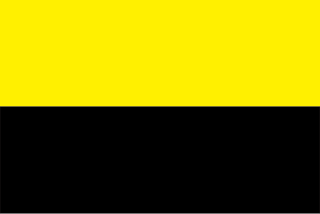
Sultanate of Banjar or Sultanate of Banjarmasin was a sultanate located in what is today the South Kalimantan province of Indonesia. For most of its history, its capital was at Banjarmasin.
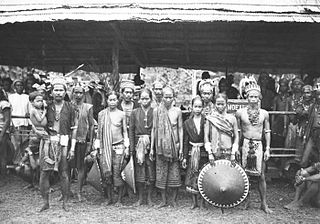
Mualang are an indigenous people of West Kalimantan from the Dayak group and a sub-ethnic of the Iban people. They speak the Mualang language and they are mostly concentrated in areas in the Sekadau Regency and Sintang Regency of West Kalimantan, Indonesia. The specific districts where the Mualang people live include:
- Belitang Hilir district, Sekadau
- Belitang district, Sekadau
- Belitang Hulu district, Sekadau
- Sepauk, Sintang and its surrounding region
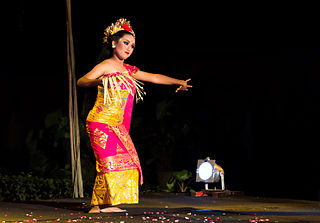
Panyembrama is a secular Balinese dance form designed by I Wayan Berata and first performed in 1971. It includes movements from several sacral Balinese dances. The dance was intended to replace for performances in front of tourists.
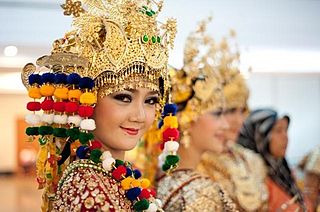
Gending Sriwijaya is the name of the traditional performance whether it is a song, music, as well as dance that originated from Palembang, South Sumatra, Indonesia. Both of the song and the dance was created to describes the splendor, cultural refinement, glory and the grandeur of Srivijaya empire that once succeed on unifying the western parts of Indonesian archipelago and Malay world generally.

The Kalimantan Physical Revolution was an armed conflict between Indonesian nationalists and pro-Dutch forces in Dutch Borneo in the second half of the 1940s. It began with the end of the Japanese occupation of the Dutch East Indies and the 1945 Proclamation of Indonesian Independence by Sukarno and lasted until the Dutch withdrew from most of Indonesia in 1949. It can be considered part of the larger Indonesian National Revolution.

BRT Banjarbakula, also informally known as "Tayo bus", is a bus rapid transit (BRT) system serving Greater Banjarmasin metropolitan area, encompassing Banjarmasin, Banjarbaru, and parts of Banjar Regency in Indonesia. It comprises three routes and more than 37 bus stops as of 2019. After several months of trials with free service, it launched on 14 August 2019 to coincide with the celebration of 69 years since the creation of South Kalimantan province. The local government plans to expand the system to 6 routes and a total of 112 bus stops, encompassing the entire Banjar regency, Tanah Laut regency, and Barito Kuala regency; covering the entire metropolitan area with service. The government is also considering handing operations to a private firm in 2021 to boost its development. As of September 2020, recruitment of new drivers for the service was stalled because of the COVID-19 pandemic, hampering route and fleet expansion needed to keep up with demand.

Lengger is a traditional Javanese dance originating from Banyumas, Central Java, Indonesia. This dance is played in pairs, between a man and a woman. Lengger dance is one of the sacred dances in Java.
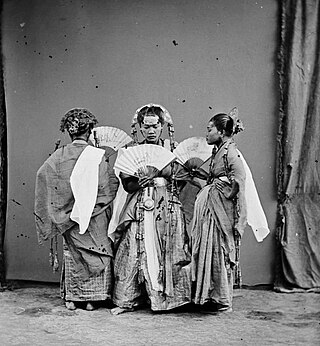
Pajoge dance is a traditional Bugis and Makassar dance originating from Bone, South Sulawesi, Indonesia. The term Pajoge has three meanings at once. From the word joge which means a 'dance', the word pa and joge refers to 'dancers', as well as a 'performance'.

Yapong dance is a Betawi dance originating in Jakarta, Indonesia. This dance depicts the association of young people created by the artist Bagong Kussudiardja. The Yapong dance was performed for the first time to enliven Jakarta's 450th anniversary event in 1977.

Kebagh dance, formerly known as the Semban Bidodari, is a traditional Palembang dance originating in Pagaralam, South Sumatra, Indonesia. This dance is characterized by the movement of opening both hands, such as spreading wings, and is usually performed to welcome distinguished guests in traditional ceremonies.
Banjar Mask Dance is a local indigenous art form of Banjar in South Kalimantan, Indonesia. It is called mask dance because the dancers use masks (Topeng) when dancing. This dance is usually played for sacred ceremonies, such as the manyanggar ceremony. The ceremony is a ritual to clean inherited equipment, treat supernatural diseases, give thanks after harvesting, cleansing the village of evil spirits, and ask for protection from disasters. The Banjar mask dance will be performed in the form of a wayang wong, where the dancers will wear masks and are accompanied by a set of gamelan salendro.
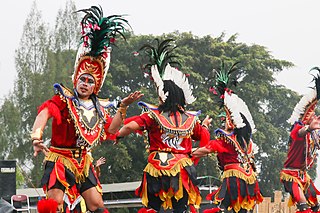
Ireng mask dance also known as Topeng Ireng or Dayakan is a traditional Javanese art that developed in Magelang Regency, Central Java, Indonesia.

Kurung-kurung is a traditional Banjar musical instrument originating from South Kalimantan, Indonesia. Kurung-kurung instrument is made of long wood and the bottom is made of bamboo. This musical instrument can make a sound after being pounded to the ground and the rhythm of the music released will be different from each other, to make a different rhythm, the music player will pound the instrument alternately according to the desired rhythm.




























